Physical Address
304 North Cardinal St.
Dorchester Center, MA 02124
An estimated 6.2 million Americans older than 20 years suffer from heart failure. As the population ages and heart failure treatments improve, this number is expected to increase, with more than 8 million affected individuals in 2030. The frequency of heart failure with reduced ejection fraction (HFrEF, left ventricular EF [LVEF] <40%) is decreasing, whereas that of heart failure with preserved ejection fraction (HFpEF) is increasing and has overtaken the frequency of HFrEF. A recent study of 894 patients with new-onset heart failure from the Framingham cohort notes 56% of HFpEF and 31% HFrEF from 2005 to 2014. However, while the median survival time for HFrEF improved, this change has been less for HFpEF, attesting to the lack of specific therapy ( Fig. 3.1 ).
The value of myocardial strain in the population of patients with HF is several-fold. In patients with HFrEF, strain may not be needed for the diagnosis of HF, as the decrease in LVEF is integral to the diagnosis; however, strain provides prognostic value. Strain may be useful for the diagnosis of HF with mildly reduced EF (HFmrEF) when the value of LVEF is difficult to ascertain. In HFpEF, strain is useful in both the diagnosis of the condition and in its prognosis.
Heart failure has been physiologically defined as “an inability of the heart to pump blood to the body at a rate commensurate with its needs, or to do so only at the cost of high filling pressure.” However, given the inability to directly measure LV end-diastolic pressure (EDP) in most patients at the bedside, HF is operationally a clinical syndrome diagnosed based on an established constellation of familiar signs and symptoms. To improve the uniformity of applying this diagnosis in clinical research, these signs and symptoms have been formulated into criteria with those derived by the Framingham Heart Study (Framingham criteria), the mostly commonly employed. The diagnosis of HF, as defined both by the American Heart Association (AHA)/American College of Cardiology (ACC) , and the European Society of Cardiology (ESC), relies primarily on the presence of these clinical signs and symptoms captured by the Framingham criteria. Both guidelines recommend a measure of the plasma levels of brain natriuretic peptide (BNP) or N-terminal (NT)–proBNP and the performance of an echocardiogram ( Central Illustration 3.1 ).
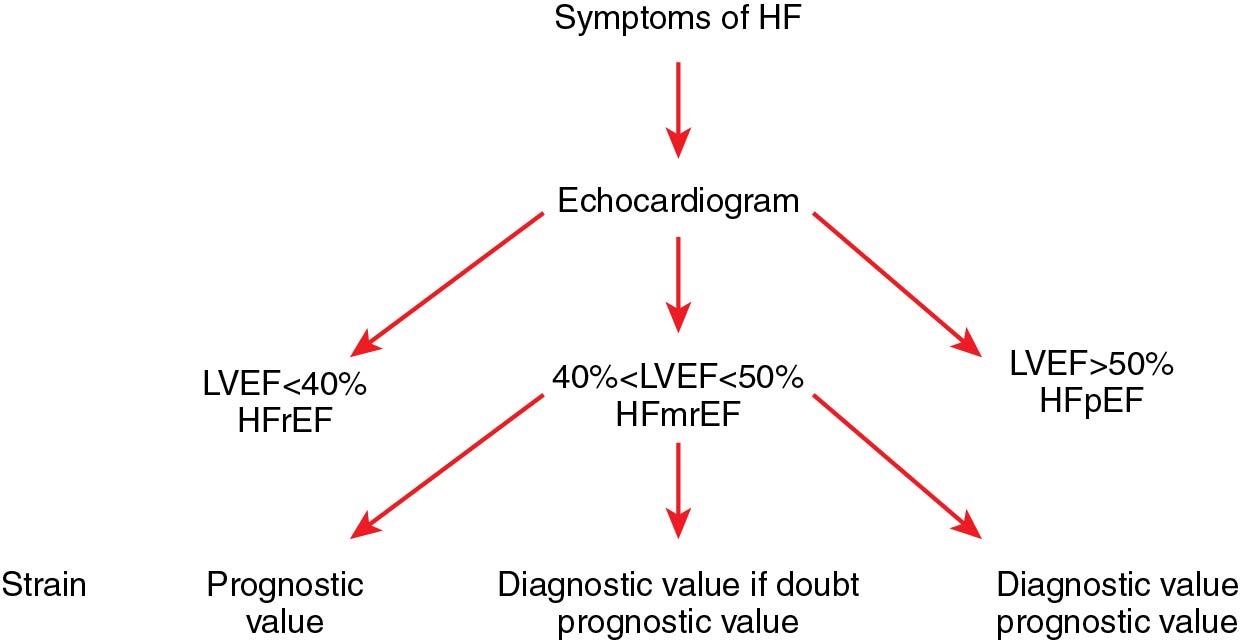
Heart failure with preserved LVEF (HFpEF) was initially recognized based on the presence of cardinal HF signs and symptoms in the context of a (relatively) preserved LVEF. , Importantly, this is also the definition used by the large majority of large epidemiologic studies that inform our understanding of the prevalence, incidence, and morbidity and mortality associated with HFpEF. However, these cardinal signs and symptoms are not specific to cardiac dysfunction, and in the context of a relatively preserved LVEF identifying a cardiac origin for these clinical signs and symptoms can often be challenging. To help address this uncertainty, the ESC further delineates thresholds for abnormal BNP/NT-proBNP and echocardiographic abnormalities in the diagnosis of HF with the LVEF preserved or only mildly reduced (HFmrEF). The echocardiographic thresholds for structural and functional abnormalities are left atrial volume index (LAVI) >34 mL/m 2 , or LV mass index ≥115/95 g/m 2 for males/females, or mean E/e′ ≥13 and mean e′ <9 cm/s. BNP is considered elevated when >35 pg/mL and NT-proBNP when >125 pg/mL. Heart failure with preserved LVEF is defined as clinical signs and symptoms of HF with structural or functional echocardiographic abnormalities and elevated BNP/NT-proBNP, and LVEF ≥50%. Noncardiac causes of dyspnea and alternate cardiac diseases causing HF symptoms (constrictive pericarditis, infiltrative cardiomyopathy, valvular heart disease, pulmonary hypertension unrelated to HF) need to be eliminated. Heart failure with mildly reduced LVEF includes clinical signs and symptoms of HF with structural or functional echocardiographic abnormalities and elevated BNP/NT-proBNP, and LVEF between 40% and 49%. Heart failure with reduced LVEF includes clinical signs and symptoms of HF and LVEF <40%. Recently, the Heart Failure Association of the ESC developed a score to help diagnose HFpEF ( Table 3.1 ); based on the literature detailed in this chapter, global longitudinal strain (GLS) is now included in this score.
| A sum of ≥5 points is consistent with HFpEF, and 2 to 4 points provides sufficient suspicion to justify diastolic stress test and/or invasive measurements. | |||
| Major (2 points) | Minor (1 point) | ||
| Functional | Septal e′ (cm/s) | <7 cm or | |
| Lateral e′ (cm/s) | <10 or | ||
| Average E/e′ | >15 or | 9–14 or | |
| TR (m/s) | >2.8 | ||
| GLS (%) | <16% | ||
| Morphologic | LAVI (mL/m 2 ) | >34 | 29–34 mL/m 2 or |
| LVMI (mL/m 2 ) | >149 (M) >122 (W) with RWT >0.42 | ≥115 (M) >95 (W) or | |
| RWT | >0.42 or | ||
| Wall thickness (mm) | ≥12 | ||
| Biomarker (SR) | NT-proBNP (pg/mL) | >220 | 125–220 |
| BNP (pg/mL) | >80 | 35–80 | |
The AHA/ACC delineates heart failure as a continuum based on clinical symptoms. Stage B, asymptomatic structural abnormalities without signs or symptoms of HF, rests on echocardiographic findings, including decreased LVEF and LV hypertrophy (of note, diastolic dysfunction and impaired strain are not included in the current definition). Although the value of biomarkers on the diagnosis of HF has been recognized, an elevation is not required for the diagnosis.
Although the diagnosis of HF may be relatively straightforward in patients with moderately or severely decreased LVEF (<40%), these definitions can lead to diagnostic inaccuracies mostly in patients with mildly reduced or preserved LVEF. The definition depends heavily on LVEF, a load-dependent and moderately sensitive index of systolic function. LVEF often remains preserved in pressure-overload pathologies, such as hypertension, and metabolic abnormalities found in obesity. Both conditions are frequent in patients with HFpEF. Additionally, the definition of diastolic dysfunction recommended by the ESC does not correspond to that delineated by the American Society of Echocardiography (ASE) ( Fig. 3.2 ). Even using the new ASE guidelines, 45% of patients have indeterminate diastolic function. Finally, although BNP/NT-proBNP are valuable tools to identify HF, the possibility of false positives in patients with renal disease, atrial fibrillation, lung diseases, sepsis, and false negatives in obese patients weaken their diagnostic value.
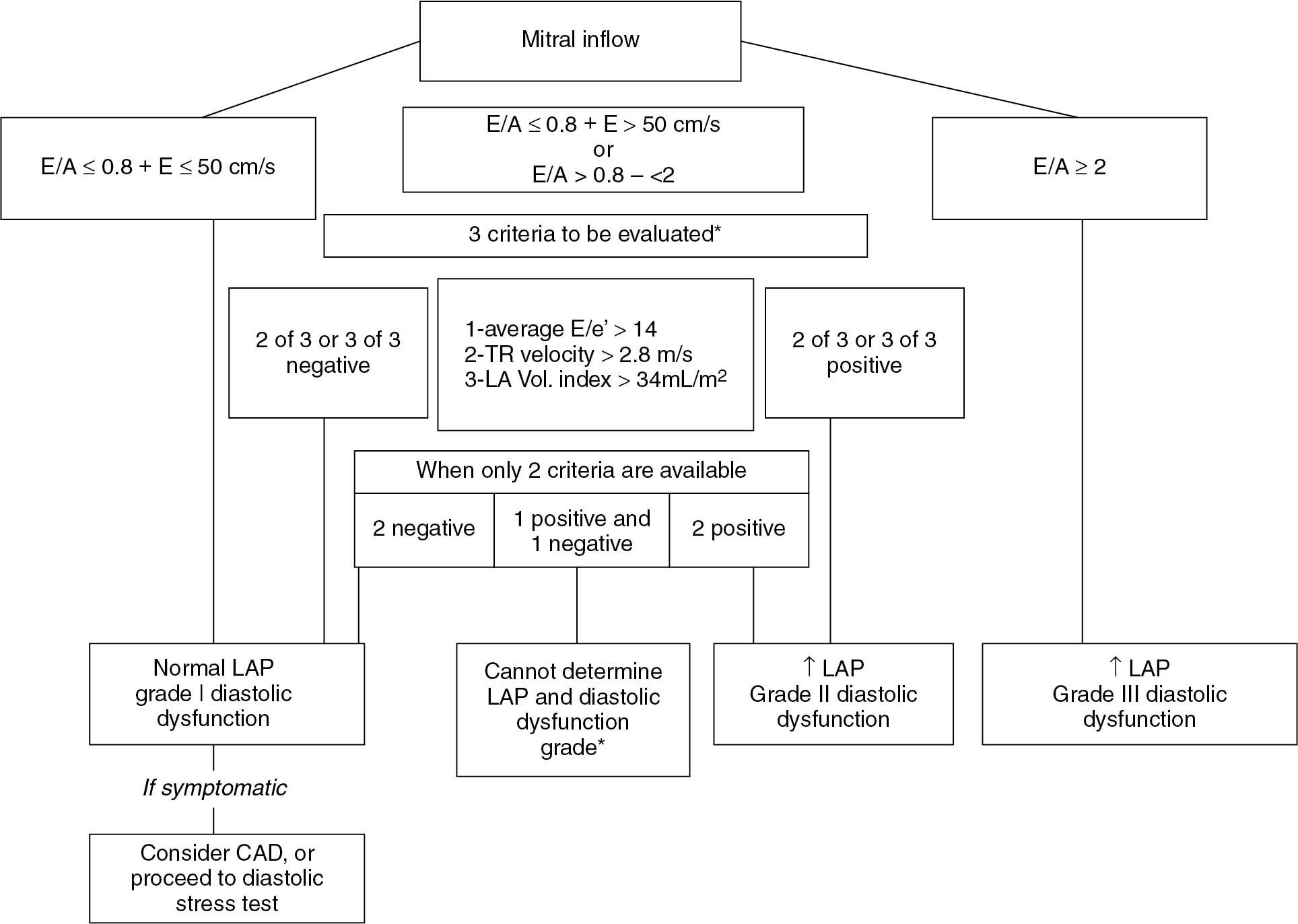
The need for more sensitive and specific measures of cardiac systolic and diastolic function to identify subtle presentations of HF or even patients at risk of HF with mild functional abnormalities has raised interest in the use of myocardial deformation indices. Left ventricular strain allows a more precise interrogation of the myocardial fiber layers, including the subendocardial layer when measuring longitudinal strain. The subendocardial layer in turn is the first layer to be affected in pressure-overload diseases such as hypertension, and in obesity. Numerous studies have demonstrated that LV GLS can be decreased in prehypertension and hypertension, , diabetes, and obesity, even as LVEF remains preserved and no structural abnormality is detected by echocardiography (stage A). For this reason, some investigators have argued that abnormal GLS could be used to define stage B HF. Among 6118 elderly participants in the community-based ARIC cohort study, incorporating LV longitudinal strain and diastolic dysfunction into the HF stages classification reclassified 14% of the population to stage B and increased the prevalence of stage B HF from 30% to 44%. In a population of patients at risk of heart failure, GLS added incremental value to clinical variables, LV hypertrophy, LA enlargement, and elevated E/e′ in the prediction of symptomatic heart failure at a mean follow-up of 14 months.
Multiple studies have reported that global LV longitudinal strain is decreased in patients with a diagnosis of HFpEF ( Fig. 3.3 ). A recent meta-analysis of 29 studies and 2284 patients with HFpEF concluded that GLS was markedly different in patients with HFpEF and healthy controls with a mean difference of −4.2% (confidence interval [CI] −5.1%, −3.4%). Abnormal GLS (defined by a GLS of >−16% ) is present in 65% in patients of HFpEF (range 37–95%, only reported in 10 of the studies). GLS was also lower in patients with HFpEF than in asymptomatic patients with cardiovascular (CV) risks factors such as hypertension or diabetes, with a mean difference of −2.8% (CI −3.7%, −1.9%). There were modest differences in LVEF in the HFpEF patients, asymptomatic patients, and healthy controls. Circumferential strain has been found to be either preserved , (as has been shown in early stages of metabolic or pressure-overload pathologies) or decreased. ,
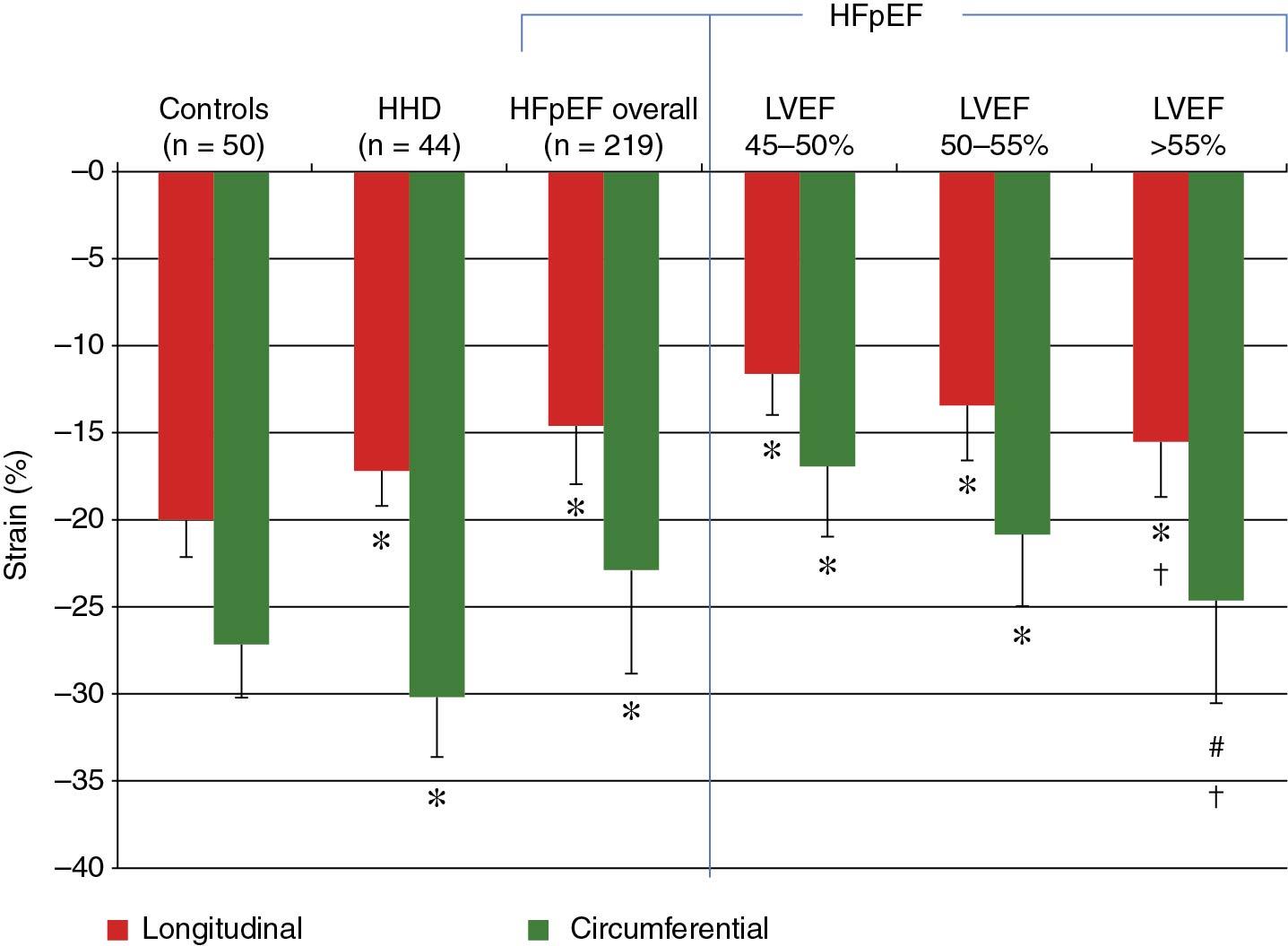
Decreased left ventricular GLS is associated with the severity of HFpEF, including increased LVEDP, higher collagen III NT propeptide plasma levels, and higher NT-proBNP plasma levels , ( Fig. 3.4 ). GLS has also been correlated to maximal exercise capacity in 37 patients with mild HFpEF (New York Heart Association [NYHA] stage II 75%, mean GLS −17.5±3.2%, mean VO 2 max 20.1±6.9 mL/kg/min), although this relationship was not identified in another study of 187 patients. Of note, the patients in the latter study were older and had more severe HFpEF (NYHA class III 52%, median GLS −14.6% [−17%, −11.9%], median VO 2 max 12.1 mL/kg/min [10.8–14.6 mL/kg/min]). The investigators speculated that the impaired functional capacity of their patients may reflect extra cardiac mechanisms and comorbid conditions rather than decreased cardiac function.
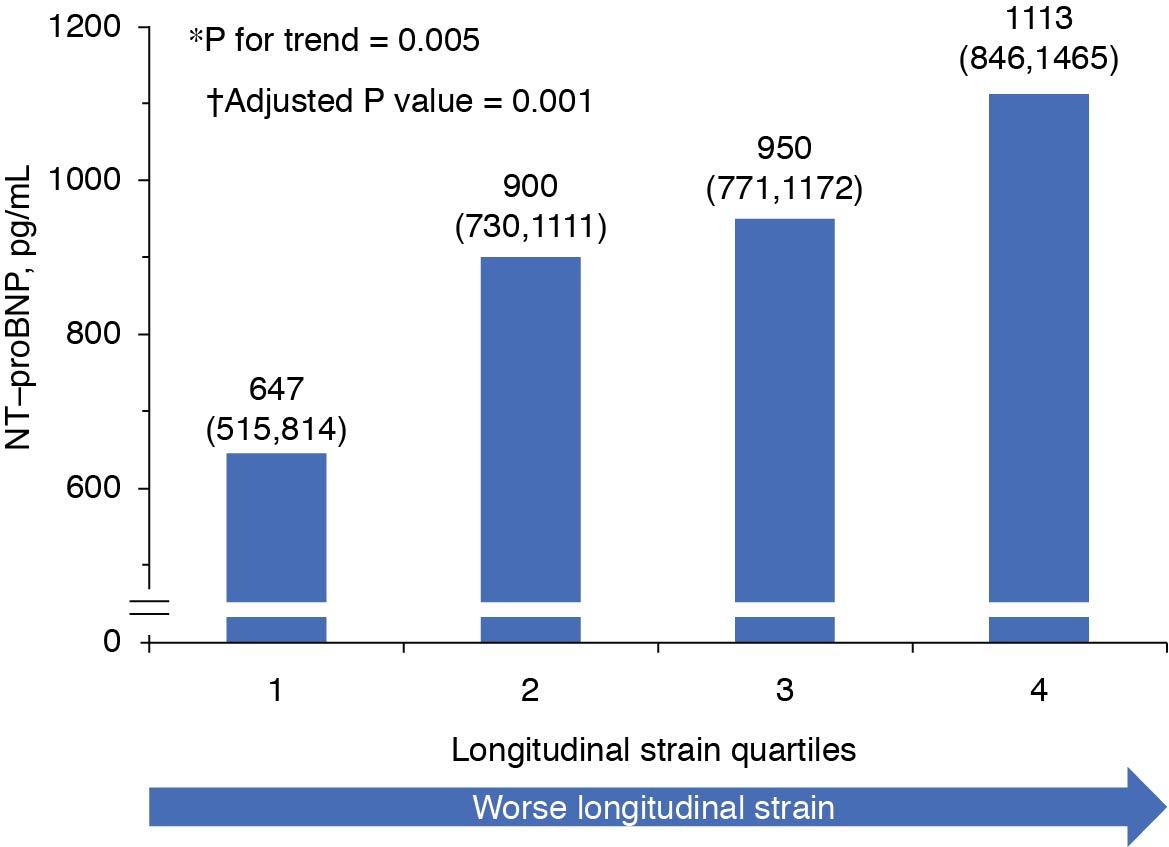
LV diastolic deformation can be measured using a variety of parameters, including longitudinal strain at one-third of the diastolic period, early diastolic strain rate (SR) (corresponding to e′) and untwist. Although these parameters are all associated with LV filling pressure ( Fig. 3.5 A), the strengths of association were not greater than with systolic parameters (see Fig. 3.5 B).
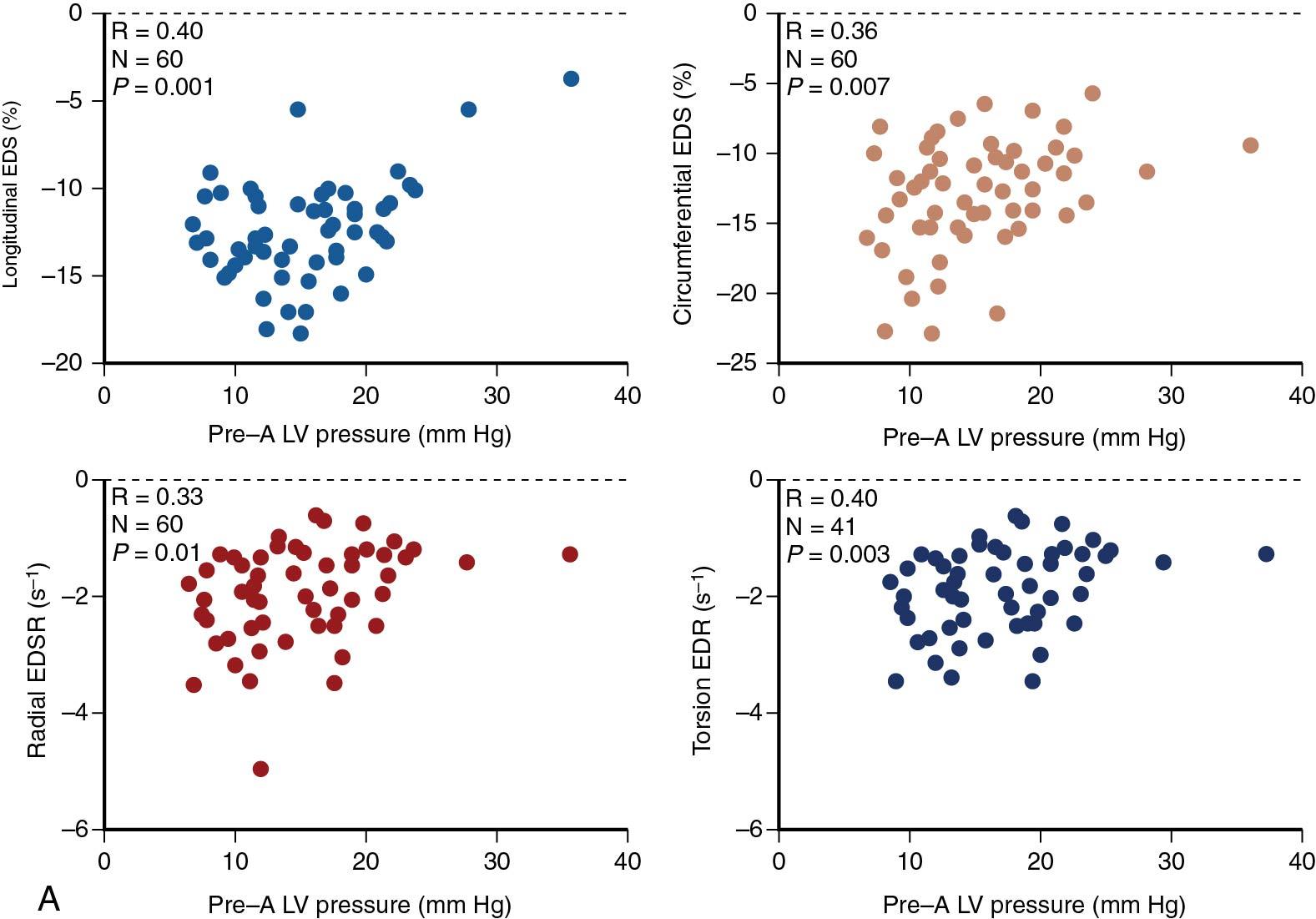
The increase of GLS with exercise is also lower in patients with HFpEF compared to healthy controls and asymptomatic patients with LV structural or functional abnormalities (GLS <18% and/or LV hypertrophy without exercise intolerance). Furthermore, the impairment in GLS recruitment worsens with the stage of HFpEF and the increase in LVEDP during exercise ( Fig. 3.6 ).
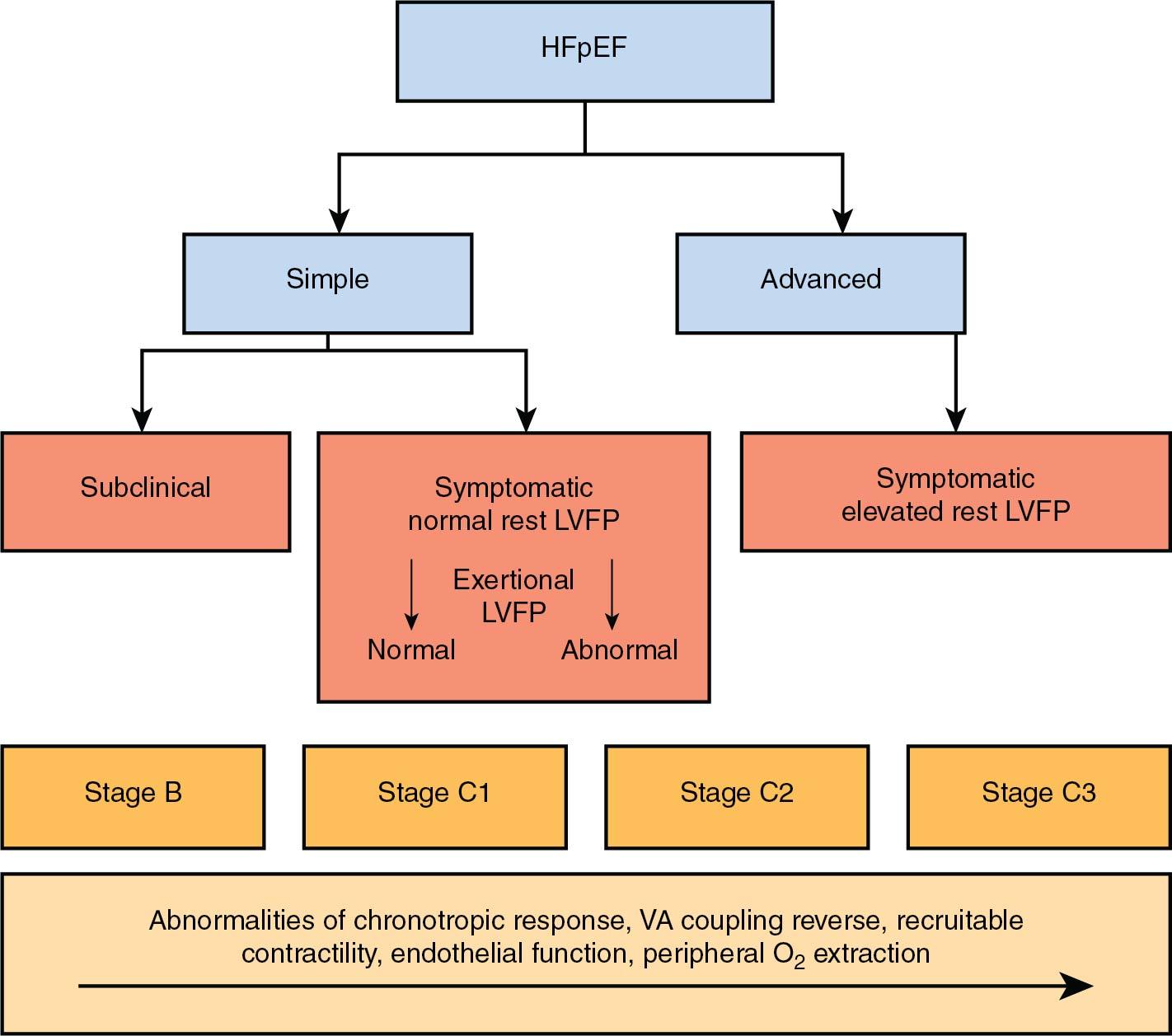
The increased LV stiffness associated with HFpEF leads to increased left atrial pressure and ultimately dysfunction. The left atrium functions as a reservoir for pulmonary venous flow during LV systole, a conduit to blood flow during early diastole and a booster pump during end diastole. These roles can be sensitively assessed using longitudinal LA strain (see Chapter 6 ). Left atrial reservoir strain is lower in patients with HFpEF compared with patients with asymptomatic diastolic dysfunction, and all components are decreased compared to age and gender matched controls. In 71 patients with exertional dyspnea, reservoir strain of <33% predicted the 49 patients with invasively verified HFpEF with 88% sensitivity and 77% specificity.
In patients with a diagnosis of HFpEF, LA strain may help to estimate the severity of the disease and functional capacity of patients. In a study of 308 patients with HFpEF, LA reservoir strain correlated with multiple invasive hemodynamic and cardiopulmonary exercise testing (CPET) indices, including elevated pulmonary artery (PA) pressures, decreased cardiac output, exercise workload, and peak VO 2 . LA reservoir strain remained associated with these indices even after adjustment for age, gender, LA volume, LV mass, and E/e′ ratio. In a study using magnetic resonance imaging (MRI), LA conduit strain was the strongest predictor of VO 2 max even after inclusion of the LV stiffness and relaxation time. These results suggest that LA function by itself plays an important role in the decrease in exercise capacity of patients with HFpEF.
Become a Clinical Tree membership for Full access and enjoy Unlimited articles
If you are a member. Log in here